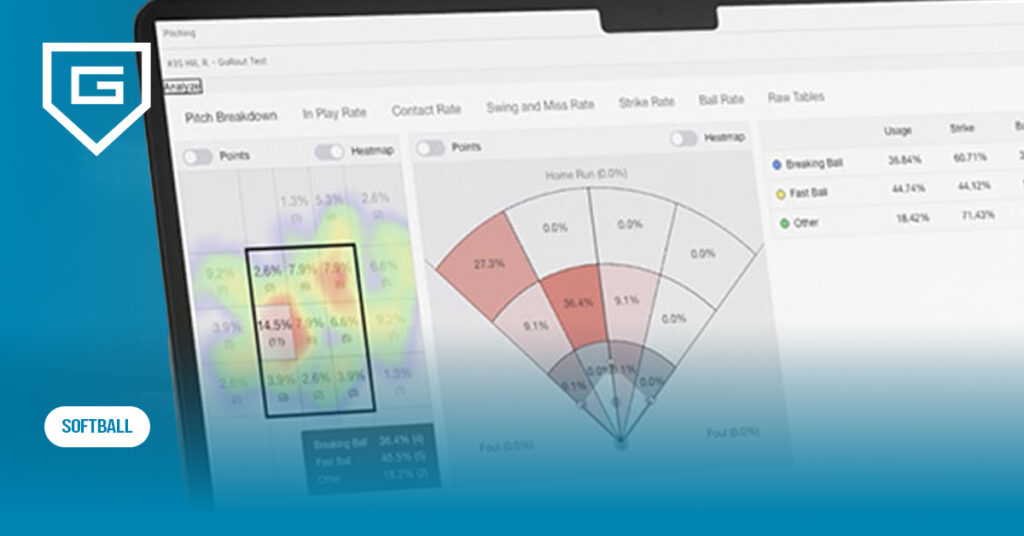How to Organize Football Workout Programs for Peak Performance
Reading Time: 11 minutes
Reading Time: 11 minutes
Football demands a lot from your players’ bodies, like strength, speed, agility, and endurance, all at once.
What’s the secret to peak performance?
Organizing your football workout programs with training phases that target each physical demand at the right time.
If you skip proper structure, even the most dedicated players can fall short or get hurt from overtraining.
This guide lays out how to structure a complete football workout program. We’ll cover strength and power, speed and agility, conditioning, and recovery.
You’ll get a look at periodization, sample weekly plans, and tips on avoiding common training mistakes that keep players from reaching their best.
The Purpose of Football Workout Programs

Football requires explosive movements. Players have to sprint, tackle, and change direction in a split second. Regular gym routines don’t cut it for these movements.
A football workout program is a structured plan to build the physical abilities your players need on the field. Your program should develop their strength, speed, power, and endurance with targeted exercises.
The main goal is to turn each athlete’s body into a strong, resilient unit that can handle the sport’s unique demands.
Timing matters too. You want training intensity to peak right before the season starts. Once games are underway, players maintain their gains with lighter workouts that won’t mess with performance.
If you don’t follow a structured approach, your athletes will waste time on exercises that don’t actually improve football performance.
Benefits of a Football Workout Plan
A structured football workout plan develops your players’ athleticism by building the exact skills they need on the field. They’ll get stronger, faster, and more powerful, and it will show in their game.
Better athletic performance
Football workouts target multiple fitness areas at once. Players build explosive power for tackles and sprints. Agility training improves the ability to make quick changes of direction.
Injury prevention
A structured football program makes muscles and joints tougher. It means players are less likely to get hurt. Strong muscles protect players during contact plays.
Mental advantages
A solid conditioning program builds confidence. Athletes feel more ready for whatever the game throws at them. Regular workouts also teach discipline and focus.
Improved sports performances
The top athletes are consistently training all year long with solid plans. Staying on top of their game puts them ahead of those who only hit the practice field during the season.
Football offseason workout programs help players grow in between seasons. They’re laying down the groundwork that sets good players apart from great ones.
Long-term development
Football training helps athletes create fitness habits that stick. Even after they hang up their cleats, they can maintain their strength and conditioning.
Core Components of Football Workout Programs
A complete football workout program combines strength training, speed work, conditioning, and recovery to build top-level athleticism.
These elements work together to give your players the explosive power and endurance they need on game day.
Strength training is the base. Football athletes need exercises like squats, deadlifts, and bench press to build real power. Their muscles have to deliver a big force during blocks, tackles, and bursts.
Speed and agility work sharpen those quick movements that set great players apart. Sprint drills, ladder work, and cone drills train their bodies to change direction fast.
Endurance and conditioning keep athletes strong all four quarters. Football plays are short with little rest. Their plan should include high-intensity intervals that mimic game conditions.
Mobility and flexibility help prevent injuries and boost performance. Dynamic warm-ups and stretching routines keep joints healthy. Players should focus on hips, shoulders, and ankles for a full range of motion.
Periodization means structuring training across the year. Build strength in the off-season, then maintain it during games. That way, players avoid overtraining and hit their peak when it counts.
Recovery protocols are just as important as the workouts. Sleep, hydration, and rest days matter. Players get stronger during recovery.
Maximize Your Offseason With GoRout’s Free Football Workout Plan
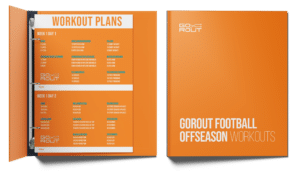
As a coach, you know the offseason is your team’s biggest chance to get ahead.
Without weekly games eating away at time and energy, you can focus on building strength, refining skills, and helping your players recover from the grind of the last season.
It’s the time when you can address individual weaknesses, improve mobility and flexibility, polish technique, and strengthen overall athletic foundation, so everyone shows up better prepared next season.
GoRout’s free Football Offseason Workout Plan is designed exactly for that purpose.
It gives you a structured, downloadable guide you can base your players’ offseason training on, including strength programming, speed and agility drills, recovery protocols, and mobility work, all laid out in a way that helps your athletes progress safely and steadily.
Whether you’re working with skill players, linemen, or multi-position athletes, this plan helps ensure no one’s left behind.
Get your players ready to dominate when the season starts.
Download GoRout’s free workout program now and transform your offseason into a springboard for success.
How GoRout Improves Football Workout Programs
GoRout boosts your team’s results with two specialized football play-calling systems that cut communication delays and ramp up practice reps.
The Scout system delivers instant play calls that double reps during practices, while Gridiron streamlines communication to every player on the field to improve game day performance.
GoRout Scout
GoRout Scout totally changes scout team operations by delivering instant play info to every player on the field. Forget huddles, paper play cards, or wasted minutes between reps.
It adapts to your routine:
- Run more plays with scout teams
- 7 on 7 football
- Special teams (KO, KOR, P, PR)
- Preparing against up-tempo teams
- Reducing install times for new players
Coaches use the web app to design their football practice plan. They send real-time, secure and encrypted play calls via the mobile app to their players.

Players get play cards right on their football play call wristbands without Wi-Fi or complicated setup. These football practice devices work in any weather, from pouring rain to blazing heat.
You’ll run more plays each practice. Most teams double their scout team reps, so your starters get better looks and more realistic prep.
You can also use it for:
- Road game/hotel walk-thrus
- Summer camps
- Captains’ practices
- Freshmen installs
Check out these testimonials and case studies.
Key benefits include:
- Instant play delivery to all scout team players
- No huddle time between plays
- Weather-resistant devices with reliable cellular connectivity
The system fits right in with your football playbook software. Just import your play images and build practice scripts using the drag-and-drop interface.
Packages start at $1,700 and are fully customizable.
GoRout Gridiron
GoRout Gridiron changes the game of in-game football communication by delivering real-time play calls directly to players’ digital wristbands. It eliminates sideline delays and miscommunication.

This football coaching software fits your program:
- Customizable device quantity based on your roster
- One button to switch offense/defense
- Works for players who play both sides of the ball
- 4-way privacy screens to protect play information
Built for game-day reliability, GoRout Gridiron runs on cellular and works in all weather, like rain, snow, or extreme heat. Devices have 6-8 hour battery life and charge to 80% in under 90 minutes.

Security is the top priority with advanced encryption and unique keys to prevent opposing teams from intercepting calls. Each device comes with a 100% breakage warranty because it’s built to be tough.
It is approved for high school use in Texas only; other states require NFHS approval. Packages start at $650 and are fully customizable.
GoRout Gridiron is the future of football communication, trusted by over 2,000 programs nationwide and proven at the collegiate level.
Strength And Power Training For Football Players
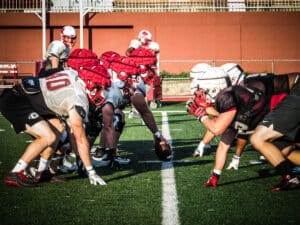
Your strength training program should focus on building explosive power and muscle mass to dominate on the field. Your players will need both upper body strength and lower body strength for tackling, blocking, and sprinting.
A solid program mixes heavy lifting with explosive moves. Most of your players’ time in the weight room should go to compound lifts that hit multiple muscle groups.
Compound lifts
The squat, bench press, and deadlift are the backbone of football strength training. These lifts build the most muscle and power in the shortest amount of time.
Squats fire up your lower body for sprinting and jumping. The bench press builds upper body and upper chest power for blocking and tackling.
Deadlifts target your whole posterior chain. This one exercise alone can boost your back, glutes, and hamstring strength.
Recommended sets and reps
For maximum strength, go for 3-5 sets of 3-6 reps at 80-90% of your max weight. This range packs on the dense muscle mass football players need.
To build power, use 3-4 sets of 1-3 reps at 90-95% intensity. Take 3-5 minutes of rest between sets to keep the quality high.
Lower body workouts should have 2-3 compound moves per session. Stick with one main lift like squats, then add some accessory work.
Olympic lifts and plyometrics
Clean and jerk movements build explosive power that shows up on the field. These lifts train your body to generate force fast.
Box jumps and medicine ball throws are great extras for your weight room routine. They connect strength to speed.
Speed-strength training
Use lighter weights (30-50% max) and move them as fast as possible. This method trains your body to produce force quickly, which is huge for football.
Try 6-8 sets of 2-3 explosive reps. Focus on moving the weight with maximum speed during each lift.
Football Speed And Agility Workouts
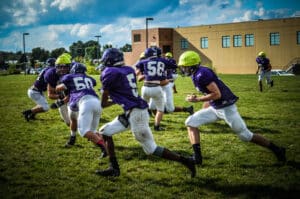
Football speed and agility training plans build explosive power through drills that improve your direction changes, acceleration and reaction time.
These workouts focus on the fast-twitch muscle moves you need in real games, as speed and agility are the backbone of football performance.
Key training components
- Agility ladder drills build precise footwork through high knees and speed
- Cone drills develop coordination between the upper and lower body during cuts
- Shuttle runs force players to stop and reverse direction instantly
- Box jumps build explosive leg strength for quick pivots in 3-5 sets
- Partner reaction drills have players react to visual and audio cues
- Mirror drills have players follow another player’s movements for better coverage
- High-intensity 10-20-yard sprints with full rest periods boost first-step quickness
- Start-stop drills from the 3-point stance help defensive linemen practice explosive starts
- Arm cycling during acceleration increases the stride rate and speed
- Sharp cuts at various angles challenge the direction change ability
Football speed and agility training turns raw athletic ability into game-ready performance.
By combining ladder work, cone drills, reaction exercises, and explosive movements, players develop the quick feet, fast acceleration and split-second decision-making skills that separate good players from great players on the field.
Endurance And Conditioning In Football Workout Programs
Building endurance for football means following a smart conditioning plan. Your players need training that matches football’s stop-and-go rhythm.
Football conditioning mixes short, high-energy bursts with quick rests. It mimics the effort of sprinting, tackling, and then lining up for the next play.
High-intensity interval training
HIIT training gives your athletes the endurance football demands, and it only takes 20–30 minutes per session. They’ll go all-out in sprints, then recover actively.
Try these HIIT patterns for football:
- 30 seconds all-out, 30 seconds rest
- 20-yard sprints, walk back to recover
- Hill sprints for 15 seconds, jog down to recover
- Sled pushes for 20 seconds, then rest for 40 seconds
Start them with 8–10 intervals. Build up to 15 rounds as they get fitter. This approach teaches their bodies to bounce back fast between plays.
Energy system development
Players tap into different energy systems during a game, so they need to train each one. The first system powers explosive plays under 10 seconds.
The second system covers moderate efforts, about 30 seconds to 2 minutes. The third handles steady, longer activities.
Use different interval lengths to hit all three:
- Short (5–15 seconds) for explosive power
- Medium (30–90 seconds) for play sequences
- Long (3–5 minutes) for overall endurance
Mix these intervals into the weekly program. If you want your athletes to handle any game situation, you’ve got to train all of them.
Mobility And Flexibility In Football Workout Plans
Mobility and flexibility work are key for keeping players healthy and moving at full capacity. The right routines help athletes cut faster, recover quicker, and reduce the risk of muscle pulls.
Every program should blend dynamic warm-ups, post-workout stretching, foam rolling, and mobility drills.
| Focus Area | Key Exercises | How It Helps |
| Dynamic Warm-Ups (Pre-Workout) |
|
Prepares muscles and joints; reduces early injury risk |
| Stretching & Recovery (Post-Workout) |
|
Improves flexibility; lowers muscle tightness after training |
| Foam Rolling & Myofascial Release |
|
Relieves muscle tension; aids recovery between sessions |
| Mobility & Yoga Drills (2x/week) |
|
Enhances smooth movement, balance, and reaction time |
When built into weekly routines, mobility and flexibility work keep players durable and game-ready.
Athletes who stay consistent with warm-ups, stretching, recovery, and mobility training avoid injuries, move sharper, and react faster on the field.
Periodization And Phases of Football Workout Programs
Periodization breaks football training into clear phases across the year. Each phase has its own goal, helping players peak at the right time while avoiding burnout and injury.
| Phase | Focus | Timing | Key Notes |
| Hypertrophy | Build muscle mass and establish a strength base | Early off-season (3–6 weeks) | Higher training volume, moderate intensity |
| Strength | Develop maximum strength and raw power | Mid off-season (3–6 weeks) | Heavy lifting, low reps, longer rest |
| Power | Convert strength into explosive, game-ready movements | Late off-season (3–6 weeks) | Olympic lifts, plyometrics, speed-strength drills |
| Recovery & Taper | Reduce training load to freshen up before big games | Pre-season or before playoffs | Lower volume, keep intensity moderate |
| In-Season Maintenance | Preserve gains and manage fatigue from games/practices | During football season (ongoing) | Lower training volume, high intensity, strategic recovery weeks every 3–4 weeks |
By cycling through phases, athletes build strength, power, and endurance step by step, instead of trying to do everything at once.
Common Mistakes And Safety Tips
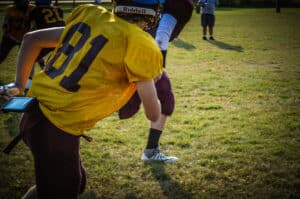
Lots of football players overdo it and skip rest. Your players need recovery days to get stronger and avoid burning out.
Have athletes watch for warning signs of injury during workouts. If they feel a sharp or shooting pain, stop immediately. If they’re still sore after 48 hours, that’s a red flag too.
Remind them: muscles grow when they rest. Players should take at least one full rest day every week and aim for 7–9 hours of sleep each night for real recovery.
Don’t let athletes bump training volume by more than 20% in a week; that’s a recipe for overuse injuries. Make sure they master the technique before adding more weight or speed. Sloppy form now can mess them up later.
Tell players to listen to their bodies every single day. Soreness is normal, but pain is the warning system, and they can’t afford to ignore it.
Conclusion On Football Workout Programs
A well-structured football training program is your players’ key to peak performance on the field. They need consistent training that includes strength, speed, and endurance work all year round.
Periodization is key. Your team’s 12-month program should include pre-season prep, in-season maintenance, and transition recovery phases. Each phase serves a purpose in their athletic development.
Your players’ success depends on a systematic approach. Start with proper fitness testing, then build the program around their specific needs and schedule.
Modern sports coaching technology can help with their training. GoRout has the latest football training tools to help you optimize your training and track progress.
Get a quote from GoRout today and see how this coach-to-player communication system can help your program.
FAQs on Football Workout Programs
What workout is best for football?
The best football workouts focus on strength, speed, power, and endurance. Programs should include compound lifts, sprint drills, agility work, conditioning, and recovery.
What is the 5 4 3 2 1 workout method?
It’s a strength training approach where you do 5 reps, then 4, then 3, then 2, then 1, increasing the weight each set to build maximum strength.
What is the 3-3-3 rule gym?
The 3-3-3 rule is a lifting guideline: 3 sets, 3 reps, 3 minutes of rest. It’s used to train heavy with proper recovery.
What is the 6 12 25 rule?
It’s a hypertrophy method: perform 6 heavy reps, 12 moderate reps, and 25 light reps back-to-back. It builds muscle endurance and size.







